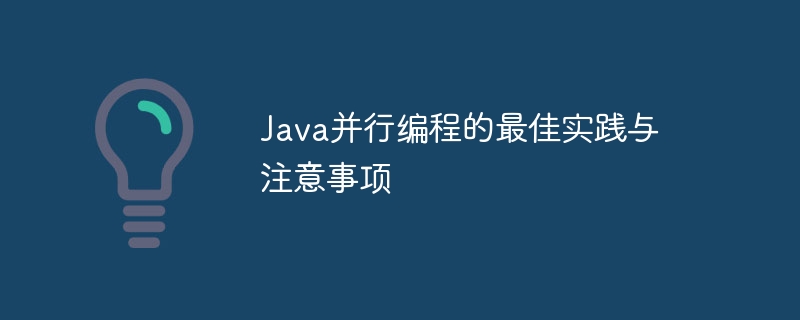Home >Java >javaTutorial >Best practices and considerations for parallel programming in Java
Best practices and considerations for parallel programming in Java
- WBOYWBOYWBOYWBOYWBOYWBOYWBOYWBOYWBOYWBOYWBOYWBOYWBOriginal
- 2024-04-18 13:03:02759browse
In Java parallel programming, it is crucial to follow best practices, including using immutable objects, synchronizing concurrent access, avoiding deadlocks, handling exceptions correctly, and using concurrency libraries. Additionally, synchronized must be used with caution, avoiding busy waits, and identifying share visibility issues. By following these principles, you can take full advantage of parallel programming while avoiding pitfalls and improving application performance.

Best practices and precautions for parallel programming in Java
In today's era of multi-core processors, parallel programming has become particularly important, it can make applications The program makes full use of multi-core processors to improve program performance. The Java language enables developers to easily create concurrent programs by providing a rich parallel API.
However, parallel programming also brings some challenges, such as thread safety, deadlocks and race conditions. In order to take full advantage of parallel programming while avoiding these pitfalls, it is important to follow best practices and considerations.
Best Practices
1. Use immutable objects
In a concurrent environment, shared state can easily lead to thread safety issues. By using immutable objects, this situation can be eliminated because the state of an immutable object cannot be changed once it is created.
2. Synchronous concurrent access
When multiple threads access shared data at the same time, it is very important to use the synchronization mechanism. Java provides a variety of synchronization mechanisms, such as locks (synchronized keyword) and semaphores (Semaphore class).
3. Avoid deadlock
Deadlock refers to a situation where two or more threads are waiting for each other to release the lock, causing all threads to be unable to continue. The best way to avoid deadlocks is to follow the lock ordering guideline, which is to always acquire locks in the same order.
4. Handle exceptions correctly
In concurrent programs, exception handling needs to be careful. Using the try-with-resources statement can ensure that resources are automatically released when an exception occurs and prevent resource leaks.
5. Using concurrency libraries
Java provides many concurrency libraries, such as ConcurrentHashMap, ConcurrentLinkedQueue and ExecutorService. These libraries provide thread-safe collection classes that simplify concurrent programming.
Notes
1. Use synchronized with caution
Although synchronized is a useful synchronization mechanism, excessive use of it will reduce program performance. Use it only when you need synchronous access to shared data.
2. Avoid busy waiting
Busy waiting means that a thread repeatedly polls a condition variable until it is true. This wastes CPU resources, so wait/notify mechanisms (wait() and notify() methods) should be used.
3. Identify shared visibility issues
Due to the Java memory model, visibility between shared variables may be delayed. Visibility of shared variables can be ensured using the volatile keyword or memory barriers.
Practical Case
Consider a simple program where multiple threads need to calculate the sum of a set of numbers in parallel:
import java.util.concurrent.*;
class SumCalculator implements Callable<Long> {
private long[] numbers;
private int start;
private int end;
public SumCalculator(long[] numbers, int start, int end) {
this.numbers = numbers;
this.start = start;
this.end = end;
}
@Override
public Long call() {
long sum = 0;
for (int i = start; i < end; i++) {
sum += numbers[i];
}
return sum;
}
}
public class ConcurrentSumCalculator {
public static long calculateSum(long[] numbers) throws InterruptedException, ExecutionException {
int numThreads = Runtime.getRuntime().availableProcessors();
ExecutorService executor = Executors.newFixedThreadPool(numThreads);
// 将数组分成多个部分,并为每部分创建计算任务
int chunkSize = numbers.length / numThreads;
List<Future<Long>> futures = new ArrayList<>();
for (int i = 0; i < numbers.length; i += chunkSize) {
int end = Math.min(i + chunkSize, numbers.length);
futures.add(executor.submit(new SumCalculator(numbers, i, end)));
}
// 收集各个部分的计算结果
long totalSum = 0;
for (Future<Long> future : futures) {
totalSum += future.get();
}
// 关闭线程池
executor.shutdown();
return totalSum;
}
public static void main(String[] args) throws InterruptedException, ExecutionException {
long[] numbers = new long[1000000];
for (int i = 0; i < numbers.length; i++) {
numbers[i] = i;
}
long sum = calculateSum(numbers);
System.out.println("Sum: " + sum);
}
}In this example, we use a ThreadPool to create a concurrent computing task that calculates the sum of a set of numbers in parallel. Note that we use Future objects to collect the calculation results of each task to ensure thread safety.
The above is the detailed content of Best practices and considerations for parallel programming in Java. For more information, please follow other related articles on the PHP Chinese website!

